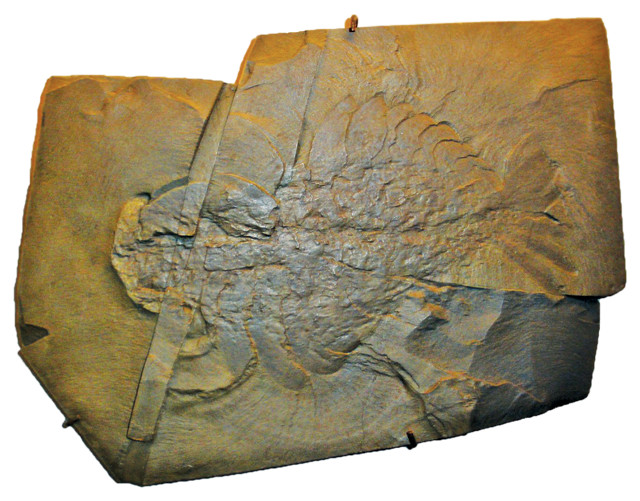
by Mary Caperton Morton Monday, June 8, 2015

Anomalocaris was the biggest, baddest predator in the Cambrian ocean. Credit: ©Ghedoghedo, CC BY-SA 3.0.
Since first appearing in the fossil record more than 550 million years ago, complex animals have steadily grown in average size, from millimeters to meters to many meters in length. This tendency of species to evolve toward larger sizes over time — known as Cope’s rule — has been studied before in individual species, such as horses and clams, but a new dataset of thousands of marine animals is giving scientists their first large-scale look at how Cope’s rule applies to whole ecosystems over hundreds of millions of years.
Named after the famous paleontologist Edward Drinker Cope, Cope’s rule was proposed in the late 1800s after researchers began studying certain groups of dinosaurs. “Lineages tend to originate small, and over time, as new species evolve, they tend to be larger than their predecessors,” says Noel Heim, a paleobiologist at Stanford University and lead author of the new study, published in Science.
Most studies considering Cope’s rule have focused on one species at a time, Heim says; classically, horses have gotten the most attention. “This is the first time that anybody has been able to take such a broad view of so many species over such a long span of time.”
To test whether the rule broadly applies to marine animals, Heim and a team of undergraduates and high school interns compiled information on fossils representing more than 17,000 genera spanning five major phyla, including arthropods, brachiopods, chordates, echinoderms and mollusks, over the past 540 million years. “Nearly 75 percent of all of marine genera in the fossil record and nearly 60 percent of all the animal genera that ever lived are included in our dataset,” Heim says.
The dataset was compiled largely by mining the Treatise on Invertebrate Paleontology, a 50-volume compendium jointly published by the Geological Society of America and the University of Kansas that includes detailed information about every invertebrate animal genus with a fossil record known to science. Using photographs and detailed illustrations of fossils in the Treatise, as well as several other literature sources and databases, the team calculated and analyzed body size and volume for 17,208 marine genera.
Heim and his student researchers found that over the past 542 million years, the maximum size of marine animals has increased by a factor of about 100,000, while the mean size across all genera studied has increased 150 fold. As an example of the latter change, “that’s the difference between [the volume of] a sea urchin that is about 2 inches long versus one that is nearly a foot long,” Heim says. “This may not seem like a lot, but it represents a big jump.”
The overall increase in body size was not due to all animal lineages steadily growing bigger, however, but rather to the preferential diversification of groups of organisms that were already larger than others early in the history of the animal kingdom, like clams and cephalopods.
“This shift toward larger size and then diversification is not surprising, but this is the first study to demonstrate it at this scale,” says David Pfennig, an evolutionary biologist at the University of North Carolina at Chapel Hill who was not involved in the new research. “Size is unequivocally important ecologically and evolutionarily,” Pfennig says. “If a lineage can escape predation or escape competition by growing larger into a new niche, then they might have greater opportunities to radiate and diversify.”
The next step is to search for the specific factors that might drive animals to evolve toward larger size. “We’re not totally sure yet what’s causing the selection toward larger size,” Heim says. “It could be as simple as predation, or something more complicated, such as metabolism or ecological dynamics of increasingly complex ecosystems over time.”
© 2008-2021. All rights reserved. Any copying, redistribution or retransmission of any of the contents of this service without the expressed written permission of the American Geosciences Institute is expressly prohibited. Click here for all copyright requests.